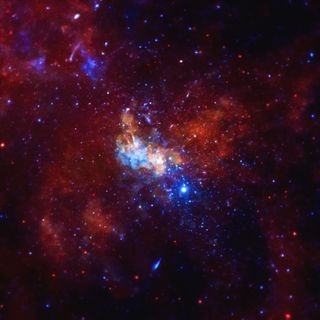Black Holes in Galactic Bellies May Launch More Gravitational Waves

Black holes in the centers of galaxies could accelerate mergers between objects and produce more ripples in space-time, also known as gravitational waves, a new study suggests.
Gravitational waves are distortions in space-time produced by encounters between massive objects, such as black holes or ultradense neutron stars. The first-ever detection of gravitational waves occurred in 2015, accomplished by scientists using the Advanced LIGO (Laser Interferometer Gravitational Wave Observatory). This happened when two large black holes (29 and 36 times the mass of the sun) merged into one, creating space-time ripples.
Since then, there have been several detections of other sets of gravitational waves.
"These observations show that BH [black hole] mergers are commonplace in the universe," researchers said in a statement from the Royal Astronomical Society. "However, we are still not sure how these sort[s] of binary systems form. This is because they need to be on very close or very eccentric orbits in order to collapse in such a way that GWs [gravitational waves] are observable."
The new study suggests that systems of two dense objects like black holes can merge faster inside the typical heart of a galaxy, where a supermassive black hole resides. The research was led by Ph.D. student Joseph Fernandez, an astrophysics researcher at Liverpool John Moores University in England.
Often, a pair of objects passing by a black hole will be separated if they get too close to the object, because the black hole's gravitational field will tear them apart. Sometimes, however, the binary will survive the encounter — but the objects' orbits will be severely modified, the researchers said.
Fernandez's team ran several simulations and concluded that surviving binary systems would have tighter and more-eccentric orbits between the two objects after passing by black holes. This would make their situation ripe for a merger, because they would be much closer to each other than before, the researchers found.
Get the Space.com Newsletter
Breaking space news, the latest updates on rocket launches, skywatching events and more!
"This could be sufficient to force binaries that wouldn't merge within the lifetime of the universe to do so sooner, leading to observable gravitational waves," researchers said in the statement.
Fernandez presented his research April 3 at the European Week of Astronomy and Space Science in Liverpool.
Follow us @Spacedotcom, Facebook and Google+. Original article on Space.com.
Join our Space Forums to keep talking space on the latest missions, night sky and more! And if you have a news tip, correction or comment, let us know at: community@space.com.

Elizabeth Howell (she/her), Ph.D., is a staff writer in the spaceflight channel since 2022 covering diversity, education and gaming as well. She was contributing writer for Space.com for 10 years before joining full-time. Elizabeth's reporting includes multiple exclusives with the White House and Office of the Vice-President of the United States, an exclusive conversation with aspiring space tourist (and NSYNC bassist) Lance Bass, speaking several times with the International Space Station, witnessing five human spaceflight launches on two continents, flying parabolic, working inside a spacesuit, and participating in a simulated Mars mission. Her latest book, "Why Am I Taller?", is co-written with astronaut Dave Williams. Elizabeth holds a Ph.D. and M.Sc. in Space Studies from the University of North Dakota, a Bachelor of Journalism from Canada's Carleton University and a Bachelor of History from Canada's Athabasca University. Elizabeth is also a post-secondary instructor in communications and science at several institutions since 2015; her experience includes developing and teaching an astronomy course at Canada's Algonquin College (with Indigenous content as well) to more than 1,000 students since 2020. Elizabeth first got interested in space after watching the movie Apollo 13 in 1996, and still wants to be an astronaut someday. Mastodon: https://qoto.org/@howellspace
